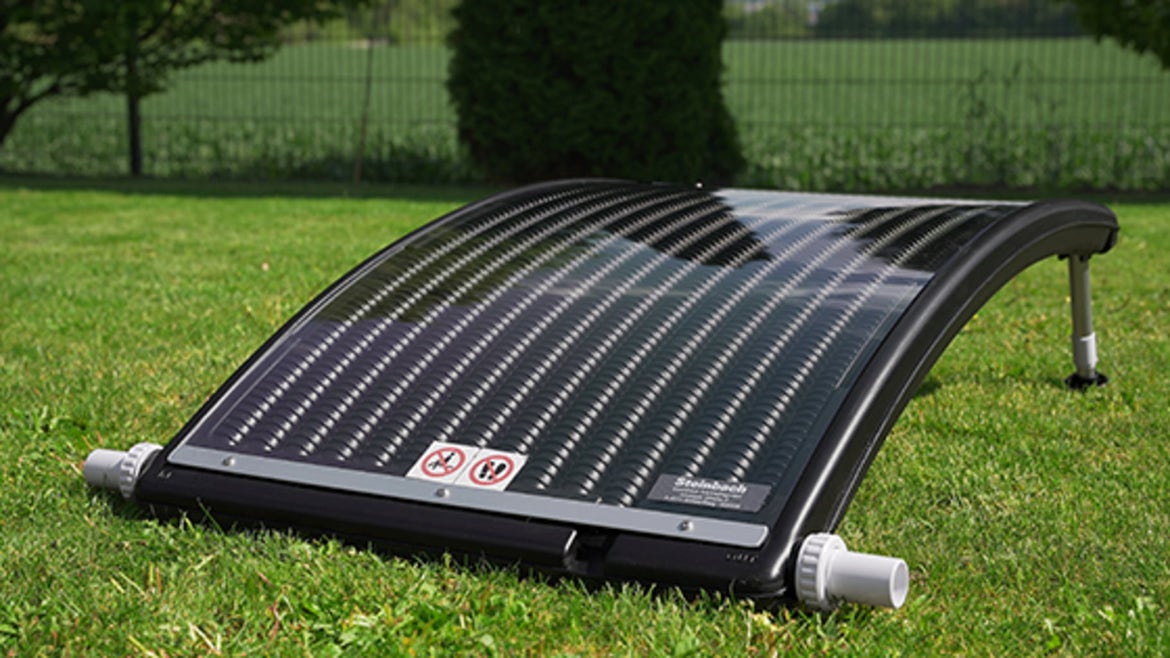Heating Your Pool - Tips & Tricks
Heating a pool is not easy without some background information. Here are some tips on how you can heat your pool efficiently and economically.
Pool Heating: The Basics
Pool water temperature usually adjusts to the ambient temperature. The greater the temperature difference, the faster and easier it is. For instance, cold water is very easy to heat when the ambient temperature is warm. As a general rule of thumb, warming up by the first few degrees Celcius is rather easy. But if the conditions remain the same, it becomes increasingly difficult to increase the water temperature. The reason is that heat dissipates into the environment. When heating a pool, it is not only about providing energy for heating up the water but also about avoiding heat loss. The basic requirement for good results is when you combine both methods.
Warm Water Needs A Lot of Energy!
Unfortunately, it is often underestimated how much energy water can absorb and store. Or to put it another way, water is very hard to heat. A small comparison shows the ratios: An average electric water kettle needs about 1,000 watts for 1 litre of water. A good pool setup has around 0.4 to 2.5 watts of external pool heating output per litre of water! Unfortunately, many novice pool owners use only 0.05 or 0.1 watts per litre - with high heat loss on top of that - and are surprised at the lack of results.
Heating The Pool With The Help Of The Sun
In latitudes like Germany, the sun creates between 1,100 and 1,200 watts per square metre on good days. Even if we subtract 20-30% due to light reflection, on a good day we can still expect about 770-960 watts per square metre. On sunny days in midsummer, the sun will probably heat your pool more than your pool heater. And by a considerable amount. For example: A 450cm steel wall pool has a surface area of approx. 16m². On good days, the sun feeds 12.3-15.3 kW (after accounting for losses due to reflection) directly into your pool. You can surpass this only by using the most powerful heat pumps or extremely large solar panels!
Solar Energy
Not surprisingly, on warm and sunny days, pool water temperatures can reach 28-29°C without external heating or insulation. However, as expected, this happens on only a few days every year. That's because the sun is not always overhead but is usually lower in the sky depending on the season. The number of hours of sunshine also decreases the further you are from June - both forwards and backwards. If we factor in clouds, it is clear that the amount of energy we can expect from the sun varies wildly. Therefore, our goal is to minimise and compensate for the downward fluctuations by adding energy and/or limiting heat losses through radiation.
Heating The Pool: The First Steps
The cheapest step in heating a pool is to use a solar tarpaulin. Not only does it efficiently direct the sun's energy to the pool water but it also insulates! The energy that comes in escapes much more slowly with a solar tarp. Above all, heat losses at night are greatly reduced. As a result, the pool water retains its heat much better. You can expect a relative advantage of 2-3°C in real conditions at latitudes like Frankfurt or Berlin. On rare days we can expect more, but that's the exception. A relative advantage means how warm the water in a pool is with and without a solar cover. Misunderstandings can arise especially during severe cold spells: Cooler pool water can certainly be a success if it were significantly cooler without a solar tarp. Since a solar tarp is not very expensive and there are no maintenance costs, we recommend using it as a first step.
Pool Heaters: An Overview
Now that we know that any additional energy fed into the pool water will not be lost due to radiation with the use of a solar tarp, let's take a look at classic pool heaters. Solar heaters and electric heaters are suitable for everyday use with above-ground pools and are divided into several sub-types.
a) Pool Heating With Solar Panels
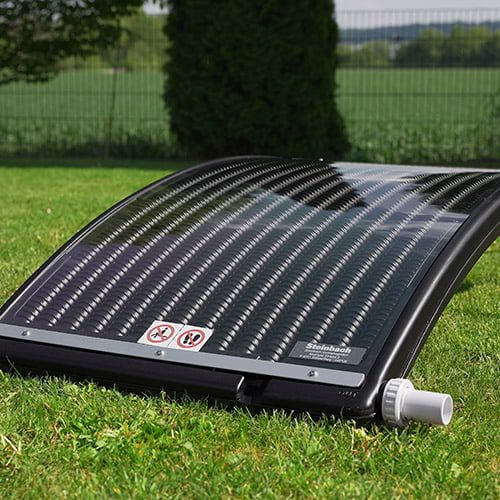 Solar collectors are popular because they do not have any maintenance costs and can feed significant amounts of heat into the pool. The emphasis here is on the word can. New pool owners in particular tend to take solar collectors that are too small. Even if some of our cleverly designed products give a few percent more. When in doubt, the following always applies: surface area can only be replaced by even more surface area. Therefore, the rather small - although efficient - Speedsolar Solar Collectors should only be used when the space available is very limited. If there is more space available, the Steinbach Exclusive Solar Collector would always be preferable to the Speedsolar model. Why? Because the Exclusive Collector offers a whopping 130% more surface area (!!!) for an additional price of just 15%. Since the Exclusive Collector is also angled, it also offers the same efficiency as the Speedsolar.
Solar collectors are popular because they do not have any maintenance costs and can feed significant amounts of heat into the pool. The emphasis here is on the word can. New pool owners in particular tend to take solar collectors that are too small. Even if some of our cleverly designed products give a few percent more. When in doubt, the following always applies: surface area can only be replaced by even more surface area. Therefore, the rather small - although efficient - Speedsolar Solar Collectors should only be used when the space available is very limited. If there is more space available, the Steinbach Exclusive Solar Collector would always be preferable to the Speedsolar model. Why? Because the Exclusive Collector offers a whopping 130% more surface area (!!!) for an additional price of just 15%. Since the Exclusive Collector is also angled, it also offers the same efficiency as the Speedsolar.
Solar Mats - A Great Option for Large Areas
And if space is not an issue at all? Then solar mats are the best choice. Why? Because you get a lot of collector area for the money. The Speedsolar 0.7.6.0 m solar mat has almost six times the surface area of the Exclusive Solar Collector. And is in a similar price range! If you don't place the solar mats at an angle, you will lose some efficiency. But even so, they offer a huge advantage! In general, good solar panel setups should cover at least 25% of the area of the pool to be heated. This minimum recommendation can only be achieved cheaply with solar mats. And of course, you can install more - 35%, 50% or even 100% of the pool area! Heating a pool is extremely complex and you can never have too much.
b) Heating A Pool With Immersion Heaters
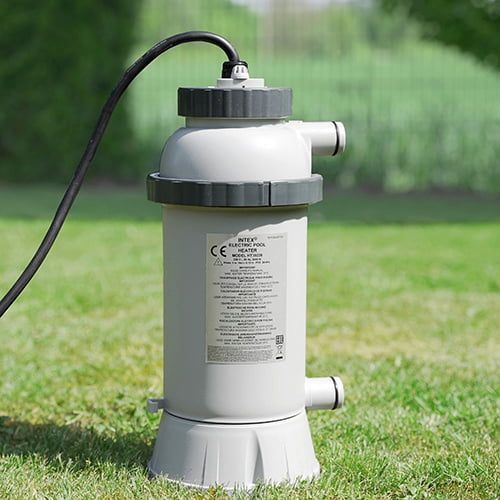 Such heaters are rather inexpensive to buy and the technology is quite simple: electricity is converted directly into heat and fed to the water. We offer the 3kW model from Intex. It can be used for targeted and short-term use in pools with a maximum volume of 15m³. The maintenance costs for long-term use, however, are enormous. They should therefore be used only infrequently.
Such heaters are rather inexpensive to buy and the technology is quite simple: electricity is converted directly into heat and fed to the water. We offer the 3kW model from Intex. It can be used for targeted and short-term use in pools with a maximum volume of 15m³. The maintenance costs for long-term use, however, are enormous. They should therefore be used only infrequently.
c) Weather-Independent and Efficient: Heat Pumps
With our heat pumps you can extend your pool season and significantly increase the temperature of the pool water. These devices work like a refrigerator in reverse and are ideal for heating the pool because, depending on the ambient conditions and model, up to 6 watts of heat energy are generated from one watt of electricity. Heat pumps are especially useful when the sun is delivering very little energy. If you want to have a warm pool during such phases and without sky-high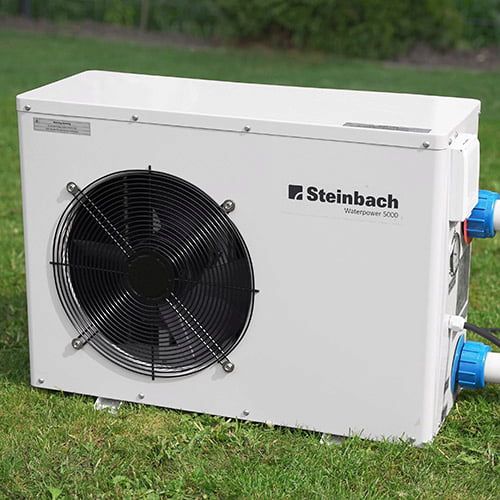 maintenance costs, using a heat pump is the best option. The Mini heat pump is suitable for smaller pools. But "small" is relative. Is it enough for you to compensate for temperature fluctuations in summer? Do you want to extend the pool season? Then go up to 20m³. Comparatively quick results and a noticeable extension of the pool season are possible up to 12m³. For larger pools, we recommend the Steinbach Waterpower heat pumps. The largest model has a heat output of up to 8,500 watts - with only 1,450 watts of power consumption. You can also heat larger frame pools comfortably with it.
maintenance costs, using a heat pump is the best option. The Mini heat pump is suitable for smaller pools. But "small" is relative. Is it enough for you to compensate for temperature fluctuations in summer? Do you want to extend the pool season? Then go up to 20m³. Comparatively quick results and a noticeable extension of the pool season are possible up to 12m³. For larger pools, we recommend the Steinbach Waterpower heat pumps. The largest model has a heat output of up to 8,500 watts - with only 1,450 watts of power consumption. You can also heat larger frame pools comfortably with it.
Heating The Pool: Tips & Tricks
- Pool mats can help insulate your pool from the cold ground. The thicker the pool mat and the higher the temperature difference between the ground and the pool water, the greater the advantage.
- Let your heat pump run, especially during the day. Heat pumps work more efficiently at warmer ambient air temperatures. Maximum efficiency is achieved at an air temperature of 26°C.
- The sun is a significant factor. Make sure your pool is placed in the sunniest spot you have.
- If you're planning on digging to make an in-ground pool, insulate it well on all sides. The effect is significant.
- Combine a solar tarp and pool mats for best results.
Heating your pool: You can find more helpful advice and video tutorials on the pools from our friendly colleagues, the pool experts at Poolpanda
Related products
-
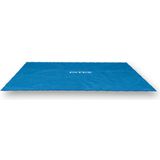 3.8 (71)
3.8 (71)Intex Solar Bubble Film for Frame Pool Ultra Quadra, 1 Pc
- Easy to use
- Increases water temperature by 3-5°C
- For a longer pool season!
€ 55,03Delivery by January 23
-
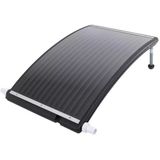 4.5 (36)
4.5 (36)Steinbach Solar Collector Exklusiv, 1 Piece
- Max. flow rate: 10,000 L/h | 10 m³/h
- Collector water capacity: 12 litres
- Dimensions: 110 x 69 x 14 cm
€ 147,76Delivery by January 23
-
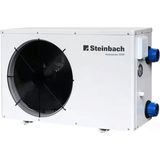 4.8 (45)
4.8 (45)Steinbach Waterpower Heat Pump 5000, Waterpower 5000
-13% Bestseller- For heating & cooling
- Also suitable for saltwater pools
- Max. pool volume 30,000 L
€ 772,55 € 891,56Delivery by Monday, 26 January
-
 5.0 (6)
5.0 (6)Steinbach Speedsolar Solar Collector, Set of 2 incl. connections and pipes
-11%- Max. flow rate: 7,500 L/h
- Water capacity of the collector: 5 litres
- Dimensions: 58 x 58 x 33 cm
€ 286,60 € 321,74Not available at the moment

